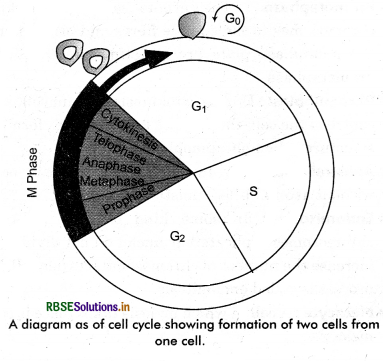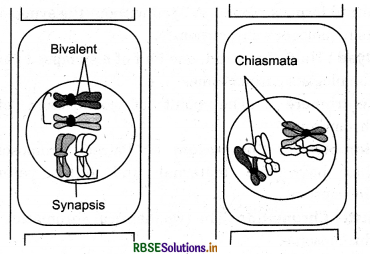RBSE Solutions for Class 11 Biology Chapter 10 Cell Cycle and Cell Division
Rajasthan Board RBSE Solutions for Class 11 Biology Chapter 10 Cell Cycle and Cell Division Textbook Exercise Questions and Answers.
Rajasthan Board RBSE Solutions for Class 11 Biology in Hindi Medium & English Medium are part of RBSE Solutions for Class 11. Students can also read RBSE Class 11 Biology Important Questions for exam preparation. Students can also go through RBSE Class 11 Biology Notes to understand and remember the concepts easily.
RBSE Class 11 Biology Solutions Chapter 10 Cell Cycle and Cell Division
RBSE Class 11 Biology Cell Cycle and Cell Division Textbook Questions and Answers
Question 1.
What is the average cell cycle span for a mammalian cell?
Answer:
It is approximately 24 hours.

Question 2.
Distinguish cytokinesis from karyokinesis.
Answer:
The division of cytoplasm along with cell organelles into daughter cells is called cytokinesis, while division of nucleus (chromosome duplication) into daughter nuclei is called karyokinesis.
Question 3.
Describe the events taking place during interphase.
Answer:
Interphase involves a series of changes that prepare a cell for division. It is the period during which the cell experiences growth and DNA replication in an orderly manner. Interphase is divided into three phases.
- G1 Phase: It is the stage during which the cell grows and prepares its DNA for replication. In this phase, the cell is metabolically active.
- S Phase: It is the stage during which DNA synthesis occurs. In this phase, the amount of DNA (per cell) doubles but the chromosome number remains same.
- G2 Phase: In this phase, the cell continues to grow and prepare itself for division. The proteins and RNA required for mitosis are synthesised during this stage.

Question 4.
What is G0 (quiescent phase) of cell cycle?
Answer:
G0 or quiescent phase is the stage where in cells remain metabolically active but do not proliferate unless called to do so. Such cells are used for replacing the cells lost during injury.
Question 5.
Why is mitosis called equational division?
Answer:
Mitosis is called equational division because during this division, one parent cell (2n) divides into two daughter cells (2n) in which number of chromosoms remain same as the parent cell.
Question 6.
Name the stage of cell cycle at which one of the following event occur:
(i) Chromosomes are moved to spindle equator
(ii) Centromere splits and chromatids separate.
(iii) Pairing between homologous chromosomes takes place.
(iv) Crossing over between homologous chromosomes takes place.
Answer:
(i) Metaphase
(ii) Anaphase
(iii) Zygotene of meiosis - I
(iv) Pachytene of meiosis - I.
Question 7.
Describe the following:
(a) Synapsis
(b) Bivalent
(c) Chiasmata.
Draw a diagram to illustrate your answer.
Answer:
(a) Synapsis: The pairing of homologous chromosomes is called synapsis. This occurs during the zygotene stage of prophase - I.
(b) Bivalent: Bivalent or tetrad is a pair of synapsed homologous chromosomes. They are formed during the zygotene stage of prophase - I.
(c) Chiasmata: Chiasmata represent the site where two sister chromatids have crossed over. It is formed during the diplotene stage of prophase - I.

Question 8.
How does cytokinesis in plant cell differ from that in animal cell?
Answer:
|
Plant Cytokinesis |
Animal Cytokinesis |
|
1. It occurs by cell plate formation. |
1. It occurs by cleavage or furrow formation. |
|
2. The cell plate appears at the centre and extends outwards. |
2. Cleavage |
|
3. Fusion of vesicles begins cell plate formation. |
3. Cleavage is started by contraction of a peripheral ring of microfilaments. |
|
4. A midbody is not formed. |
4. A midbody of dense material is formed at the middle of the cell. |
Question 9.
Find examples where the four daughter cells from meiosis are equal in size and where they are found unequal in size?
Answer:
(a) Spermatogenesis in human being occurs by the process of four equal sized daughter cells.
(b) Genesis in human beings occurs by the process of meiosis. It results in the formation of four daughter cells which are unequal in size.
Question 10.
Distinguish anaphase of mitosis from anaphase - I of meiosis.
Answer:
|
Anaphase of Mitosis |
Anaphase - I of Meiosis |
|
During anaphase of mitosis, the centromere splits and the chromatids separate. |
During anaphase - I of meiosis, the centromere does not split and the sister chromatids remain associated at their centromeres. |
Question 11.
List the main differences between mitosis and meiosis.
Answer:
|
Mitosis |
Meiosis |
|
1. It takes place in somatic cells. |
1. It takes place in germ cells. |
|
2. Two daughter cells are formed at the end. |
2. Four daughter cells are formed at the end. |
|
3. The number of chromosomes remains same in daughter cells as compared to those in parent cell. |
3. The number of chromosomes becomes half in daughter cells as compared to those in parent cell. |
|
4. Chromosomes replicate before each mitotic division. |
4. Chromosomes do not replicate before the second meiotic division. |

Question 12.
What is the significance of meiosis?
Answer:
- Meiosis maintains the chromosome number from generation to generation. It reduces the chromosome number to half so that the process of fertilisation restores the original number in the zygote.
- Variations are caused by the cross over and the random distribution of homologous chromosomes between daughter cells. Variations play an important role in evolution.
- Chromosomal mutations are brought about by the introduction of certain abnormalities. These chromosomal mutations may be advantageous for an individual.
Question 13.
Discuss with your teacher about:
(i) Haploid insects and lower plants where cells division occurs, and
(ii) Some haploid cells in higher plants where cell division does not occur.
Answer:
(i) In some insects and lower plants, fertilisation is a immediately-followed by zygotic meiosis, which leads to the production of haploid organisms. This type of life cycle is known as haplontic life cycle.
(ii) The phenomenon of polyploidy can be observed in some haploid cells in higher plants in which cell division does not occur. Polyploidy is a state in which cells contain multiple pairs of chromosomes than the basic set. Polyploidy can be artificially induced in plants by applying colchicine to cell culture.
Question 14.
Can there be mitosis without DNA replication in S - phase?
Answer:
Mitotic cell division can not take place without DNA replication in S phase. Two important events take place during S - phase, one is the duplication of DNA and the other is duplication of centriole. DNA duplication is important as it maintains the chromosome number in the daughter cells. Mitosis is an equational division. Therefore the duplication of DNA is important step.
Question 15.
Can there be DNA replication without cell division?
Answer:
Yes, there can be DNA replication without cell division. During cell division, the parent cell gets divided into two daughter cells. However, if there is a repeated replication of DNA without any cell division, then this DNA will keep accumulating inside the cell. This would increase the volume of cell nucleus, thereby causing cell expansion.
An example of DNA duplication without cell division is commonly observed in the salivary glands of Drosophila. The chromosome undergoing repeated DNA duplication is known as polytene chromosome.
Question 16.
Analyse the events during every stage of cell cycle and notice how the following two parameters change,
(i) Number of chromosomes (N) per cell.
(ii) Amount of DNA content (C) per cell.
Answer:
Change in chromosome and DNA content are possible at two points in cell cycle, S phase and anaphase.
S phase:
(i) No change in chromosome number (1N or 2N depending upon the tissue) but each chromosome replicates to become double stranded.
(ii) DNA content double (1C to 2C in haploid cells and 2C to 4C in diploid cells).
Anaphase:
(i) Number of chromosomes remains the same but the two strands or chromatids separate and form independent chromosomes which pass to different poles. In meiosis anaphase - I involves the separation of chromosomes from bivalents (2N) and their passage to different poles (1N).
(ii) DNA content decrease to one half in mitosis (2C to 1C), meiosis - I (4C to 2C) and meiosis - II (2C to 1C).

- RBSE Solutions for Class 11 Biology Chapter 9 Biomolecules
- RBSE Solutions for Class 11 Biology Chapter 8 Cell: The Unit of Life
- RBSE Solutions for Class 11 Biology Chapter 7 Structural Organisation in Animals
- RBSE Solutions for Class 11 Biology Chapter 6 Anatomy of Flowering Plants
- RBSE Solutions for Class 11 Biology Chapter 5 Morphology of Flowering Plants
- RBSE Solutions for Class 11 Biology Chapter 4 Animal Kingdom
- RBSE Solutions for Class 11 Biology Chapter 3 Plant Kingdom
- RBSE Solutions for Class 11 Biology Chapter 2 Biological Classification
- RBSE Solutions for Class 11 Biology Chapter 1 The Living World
- RBSE Solutions for Class 11 Biology Chapter 5 पुष्पी पादपों की आकारिकी
- RBSE Class 11 Biology Important Questions Chapter 1 The Living World